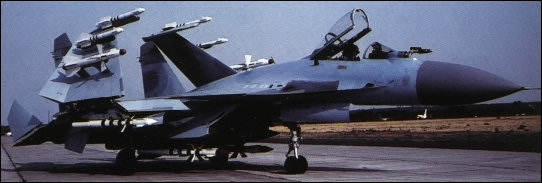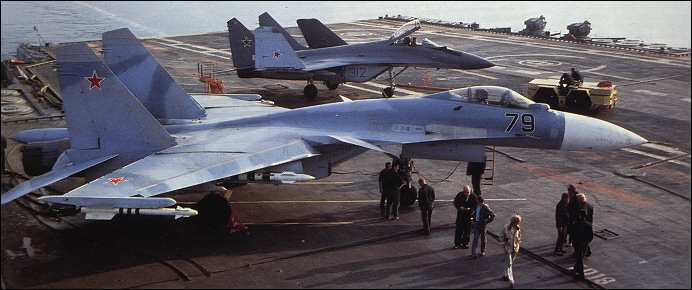Development of the Su-27K was intended to produce a shipborne long-range interceptor to complement MiG-29Ks in air wings that would equip the Soviet Union's four new conventional aircraft-carriers. One carrier was never started, another (Ulyanovsk) was scrapped on the slipway, and Varyag (formerly Riga) remains incomplete and unlikely to enter Russian/CIS service, leaving only Kuznetsov in service with the Russian Navy. This makes the provision of one dedicated carrierborne fighter (let alone two) an extremely expensive proposition, killing the original plan of having a navalised Su-27 as a kind of F-14-equivalent long-range interceptor plus a navalised MiG-29 as an F/A-18-equivalent shorter-range multi-role fighter. Although the logical decision would be to procure only the multi-role aircraft (especially since its intercept capability is identical, except in terms of range), the Su-27K still has a chance of snatching any order since the Sukhoi OKB appears to enjoy much greater political influence than its competitor.
Like the Su-27M/-35, the Su-27K can trace its ancestry back to the T-10-24, the first Su-27 to be flown with canard foreplanes, which the Sukhoi OKB studied as a means of improving take-off performance and of reducing approach speed, as well as of improving agility. Navalising the Su-27 was a major task, and resulted in a host of modifications, most of which were applied to a series of at least seven prototypes.
 This heavily armed Su-27K carrying a centreline Kh-41
Moskito ASM and a full load of AAMs sits at Zhukovskii, with wings and tailplanes folded.
This heavily armed Su-27K carrying a centreline Kh-41
Moskito ASM and a full load of AAMs sits at Zhukovskii, with wings and tailplanes folded.
The first of these, perhaps designated T-10-37, or perhaps Su-27K-1, (plus all subsequent Su-27Ks) was fitted witch canard foreplanes and an arrester hook, and also had retractable inflight-refuelling probe and the associated offset IRST. The prototype made its first flight on 17 August 1987, piloted by Victor G. Pugachev. The wing was initially unmodified, but eventually received a new, two-section double-slotted trailing-edge flap and dropping ailerons. No other Su-27 variant has ailerons, which confer better control on approach. Later prototypes had folding wings and even folding tailplanes, and were used in trials on land and aboard the Tbilisi, later renamed Kuznetsov. Victor Pugachev made the first arrested carrier shipboard landing in Soviet naval history in Su-27K '39', on 1 November 1989.
The Su-27K is based upon the airframe and weapon system of the basic Su-27, with the same radar and a virtually unchanged cockpit. It thus has minimal air-to-ground capability, unlike the competing MiG-29K, which is closely based on the airframe and systems of the multi-role MiG-29M. The Su-27K can carry a maximum ordnance load of 6500 kg (14,300 lb) and a maximum take-off weight is reduced to 32000 kg (70,546 lb). Various air-to-surface weapons have been displayed under or beside statically displayed Su-27Ks, including the massive 250-km (135 nm) range Kh-41 Moskito ASM, the anti-radar Kh-31 and the smaller Zvezda Kh-35 'Harpoonski' ASM. The Su-27K is also the first 'Flanker' sub-type plumbed for the carriage of external fuel - in this case, a 1500-litre (396-US gal) centreline tank. It was widely believed that if an Su-27K were to be selected for production, it would be a hybrid aircraft more closely based upon the Su-35, and probably with vectoring nozzles. Such supposition was denied at Le Bourget in June 1993, when it was stated that the 20 Su-33s under construction at Komsomolsk on Amur merely navalised versions of the basic interceptor Su-27, without multi-role capability or the flight control and weapon system improvements of the Su-35. 'Flanker' production at Komsomolsk was halted temporarily in early 1994, and there are reports that the more versatile MiG-29K may be put into production.

A Su-27K and a MiG-29K are seen together on the deck of the carrier Kuznetsov. The Su-27K is optimised as an interceptor.
